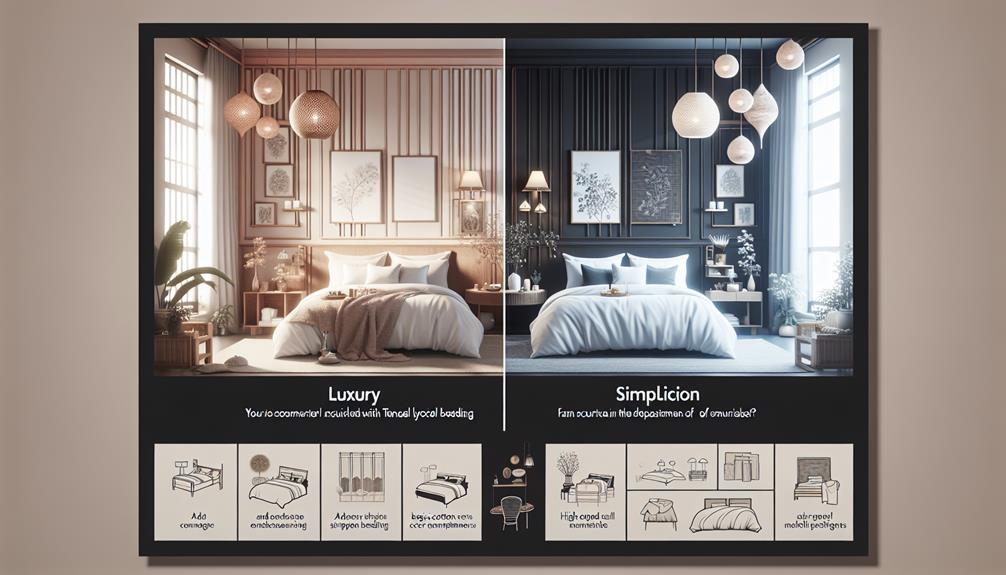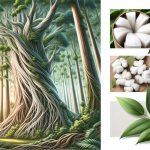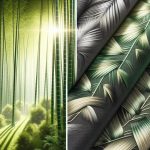Yeah, Tencel Lyocell is generally more expensive than some other fabrics like conventional cotton. This is because it's made using advanced eco-friendly techniques and high-tech processes that aren't cheap. Plus, it's sourced from sustainable wood, uses non-toxic solvents, and has a closed-loop production system which increases the cost. But you're also paying for the quality and durability, as well as the environmental benefits. It's a bit more budget-friendly compared to silk, however, while still offering a luxury feel. Interested in why it could be worth the extra cost? There's more intriguing stuff I can share about its value and sustainability benefits.
Table of Contents
Key Takeaways
- Tencel Lyocell is typically more expensive than conventional cotton due to its sustainable and advanced production methods.
- The cost reflects the use of non-toxic solvents and a closed-loop production system, reducing environmental impact.
- Sustainable sourcing of raw materials, such as certified wood pulp, contributes to the higher cost of Tencel Lyocell.
- The fabric's durability and unique properties, like superior moisture absorption and breathability, justify its higher price.
- Tencel Lyocell supports eco-friendly practices, aligning with the values of consumers who prioritize sustainability, thus influencing its price.
Understanding Tencel Lyocell
Tencel Lyocell is a fabric known for its advanced technology and eco-friendly production process that sets it apart from more conventional materials. It's a standout in the textile industry, not just for its sustainability but for its impressive qualities. I'm talking about its ability to absorb moisture, resist wrinkles, and provide breathability – all of which contribute to its premium status.
This fabric's production process is particularly noteworthy. It uses significantly less energy and fewer chemicals compared to the methods used for traditional fabrics. This sustainable approach not only minimizes environmental impact but also enhances the overall quality of the Tencel Lyocell fibers. However, this method isn't cheap. The advanced technology and stringent eco-friendly standards drive up the cost, making Tencel more expensive upfront compared to other fabrics.
Yet, what you're paying for isn't just a fabric. It's a commitment to environmental sustainability, long-term value due to its durability, and a superior comfort experience. It's a prime example of getting what you pay for in the world of textiles. So, while the sticker price might be higher, the benefits justify the cost for those who prioritize quality and sustainability.
Production Costs of Tencel
Producing Tencel Lyocell isn't cheap, due to its reliance on high-tech and eco-friendly methods. Let's break down why.
The core of Tencel Lyocell production costs lies in the advanced technology and eco-friendly processes it requires. This isn't your run-of-the-mill fabric making; it's a high-tech affair that ensures top-notch sustainability and quality.
First off, the closed-loop production system is a big deal. It recycles water and reuses the non-toxic solvents needed to turn wood pulp into soft, luxurious fibers. While this system is great for the planet, setting it up and maintaining it doesn't come cheap.
Then there's the sustainable sourcing of the raw materials—mainly wood pulp. Ensuring that these come from responsibly managed forests adds another layer of expense.
Moreover, the use of non-toxic solvents in the production process, while safer for both the environment and the workers, costs more than the harsh chemicals used in traditional fiber production.
All these factors—the cutting-edge closed-loop system, the sustainable sourcing, and the safer solvents—mean that producing Tencel Lyocell is inherently pricier. But remember, you're paying for a product that's not just high quality but also kinder to our planet.
Pricing Comparison With Cotton
When comparing prices, it's clear that I'll spend more on Tencel Lyocell than on conventional cotton. The higher cost of Tencel Lyocell can be attributed to its eco-friendly manufacturing process that uses non-toxic chemicals and sustainable sourcing practices. In contrast, conventional cotton, while cheaper, often lacks these sustainable qualities.
The pricing comparison between Tencel Lyocell and cotton isn't just about the tag; it reflects deeper values of sustainability. Tencel Lyocell requires 40% less non-renewable energy compared to cotton. This is a significant factor for those of us who prioritize environmental impacts in our purchasing decisions.
Moreover, Tencel Lyocell's unique properties like superior moisture absorption and breathability also contribute to its cost. It's not only about wearing something that feels good but also about investing in a fabric that stands up to the rigors of use while minimizing environmental harm.
Tencel Vs. Silk: Price Analysis
Silk often carries a higher price tag, making Tencel Lyocell a more budget-friendly option for those seeking luxury without the steep cost. When you dive into the price analysis between Tencel Lyocell and silk, it's clear that you're getting quite a bang for your buck with Tencel. Despite its lower price, Tencel doesn't skimp on quality or sustainability, making it a smart choice for eco-conscious consumers.
In comparison, silk screams luxury and thus, comes with a heftier price. This isn't just about the brand or the feel; it's also about the perception and the traditional value placed on silk. However, if you're like me, balancing the checkbook while trying to indulge in a bit of luxury, Tencel Lyocell stands out as the go-to. It offers similar benefits—softness, comfort, and a touch of class—at a more digestible price point.
Opting for Tencel Lyocell over silk doesn't just save you some cash; it also supports more sustainable practices in the textile industry. So, not only is it kinder to your wallet, but it's also kinder to the planet. That's a win in my book any day.
Factors Influencing Tencel Prices
Several factors drive up the cost of Tencel Lyocell, making it pricier than traditional cotton. First off, the production process for Tencel Lyocell is quite advanced. It's not just about spinning fibers; it's about transforming wood pulp into luxurious, eco-friendly fabric through a closed-loop system that recycles water and reuses solvents. This sustainable angle is a huge deal but also adds to the cost.
Moreover, the intrinsic properties of Tencel Lyocell fabric—like its durability and moisture-wicking capabilities—also contribute to its premium cost. It's designed to be gentle on the skin and the planet, which resonates well with eco-conscious consumers but does mean shelling out a bit more.
When it comes to blending fabrics, mixing Tencel with other materials can affect pricing. Depending on what it's blended with, the price can vary significantly. Here's a quick breakdown:
| Factor | Impact on Price | Reason |
|---|---|---|
| Advanced Production | High | Costly technology, sustainable practices |
| Eco-Friendly Properties | High | Environmental benefits, unique features |
| Quality and Durability | Moderate | Longer-lasting, less frequent replacement |
| Blending with Fabrics | Variable | Depends on the secondary fabric used |
| Market Demand | High | Growing popularity among eco-aware buyers |
These elements make Tencel Lyocell a sought-after but pricier option in the textile market.
Longevity and Value
Tencel Lyocell's higher price tag pays off in the long run due to its exceptional durability and eco-friendly qualities. When you're weighing whether it's worth shelling out more upfront, consider this: Tencel Lyocell doesn't just last; it maintains its shape and texture through countless washes. You won't see it shrinking or stretching out like some cheaper fabrics. That's a big win for anyone tired of replacing worn-out clothes.
Moreover, its longevity means you're investing in fewer pieces over time. Think about it—I'd rather buy one great shirt that lasts years than cycle through several that lose their fit after a few washes. It's not just about spending more initially; it's about spending smarter. This fabric's ability to endure really adds to its overall value.
And let's not forget the sustainable production side of things. The eco-friendly processes used to create Tencel Lyocell align with a growing desire to make environmentally responsible choices. That's something I'm willing to support, even if it means spending a bit more. In the grand scheme, it's not just fabric you're buying—it's peace of mind and a commitment to better practices. So, in terms of long-term value, Tencel Lyocell is definitely a winner.
Market Demand for Tencel
As the fashion industry shifts toward more sustainable practices, I've noticed a growing demand for premium fabrics like Tencel Lyocell. This surge isn't just because it's trendy; it's driven by a deeper consumer commitment to eco-friendly and sustainable production methods. Tencel Lyocell, with its impressive green credentials, has become a go-to choice for those who prioritize both the environment and fabric quality.
The market demand for Tencel Lyocell is on the rise for several compelling reasons:
- Sustainability: It's produced through environmentally responsible processes, which appeals to eco-conscious buyers.
- Performance: Its properties, like moisture absorption and breathability, make it superior in comfort and wearability.
- Longevity: Though more expensive upfront, its durability means it offers better long-term value than many traditional fabrics.
This increase in demand reflects a broader shift in consumer behavior. People aren't just looking for clothes; they're investing in pieces that align with their values. As more folks lean into sustainable living, they're willing to pay a premium for materials that promise not only style and comfort but also a lower environmental impact. For me, it's clear that Tencel Lyocell isn't just a fabric, but a statement of mindful consumption.
Availability and Sourcing
When we talk about why Tencel Lyocell might be pricier, we can't ignore where it comes from and how it's made. It's sourced from certified wood, and this sustainable approach can drive up costs.
Also, there aren't as many places making this fabric, which affects how easily it can be bought and sold.
Raw Material Sources
Often, the cost of Tencel Lyocell is driven up by the challenge of sourcing sustainable wood pulp from trees like eucalyptus. The availability of this raw material is crucial because it directly impacts the production costs and sustainability of the final product. Since we're dealing with a product that relies heavily on eco-friendly practices, the stakes are pretty high.
- Sustainable Practices: Ensuring the wood pulp is harvested sustainably keeps the ecosystem balanced but raises costs.
- Production Technology: Advanced technologies used in closed-loop systems escalate the price.
- Cost Factors: The raw material quality and sourcing logistics can significantly vary, affecting overall expenses.
These factors make Tencel Lyocell a pricier option, but they also guarantee a lower environmental impact, which is a big win.
Global Production Sites
Tencel Lyocell's production facilities are strategically located across the globe, including Austria, the US, China, Indonesia, and the UK. This wide distribution not only bolsters the availability of Tencel Lyocell but also fortifies the supply chain by integrating local manufacturing into their operations.
By setting up production sites in varied regions, they tap into local resources, which supports sustainable practices and cuts down on transportation emissions. The global presence of these sites ensures that I can source Tencel Lyocell efficiently and cost-effectively, meeting market demands without a hitch.
This setup not only helps in keeping the production sustainable but also enhances the flexibility and resilience of sourcing this eco-friendly fabric.
Supply Chain Dynamics
In navigating the supply chain dynamics, the availability and sourcing of Tencel Lyocell play a critical role in its market presence. Its premium pricing is influenced by several factors tied to its production and distribution.
- Limited Production Capacity: Less widespread than materials like cotton, contributing to higher costs.
- Ethical Sourcing Practices: Commitment to sustainability and eco-friendliness can limit sourcing options but ensures high quality.
- Advanced Production Technology: The eco-friendly methods used are more complex and costly.
Sustainable and ethical considerations make Tencel Lyocell a premium choice in the fashion industry. While this does push up the price, it's a reflection of a commitment to quality and environmental responsibility. This fabric isn't just about wearing clothes; it's about wearing values.
Impact of Sustainability on Cost
Sustainability practices in the production of Tencel Lyocell make it more expensive than conventional fabrics. It's all about how it's made and where it comes from. The materials used in Tencel are sourced sustainably, which means they're designed to have minimal impact on the environment. This sustainable sourcing isn't cheap, but it's a big part of why Tencel is considered so eco-friendly.
The production process itself also adds to the cost. Eco-friendly processes that reduce environmental impact are integral to making Tencel Lyocell, but these technologies and methods cost more than the less sustainable alternatives used in traditional fabric production. You're paying for the peace of mind that comes from supporting less pollution and resource depletion.
Despite the higher cost, the benefits of Tencel Lyocell are significant. This fabric isn't just good for the planet; it's also durable and has unique properties that other fabrics can't match. Its durability means it lasts longer, which can help justify the upfront cost. In the long run, investing in a product that won't wear out quickly can actually be kinder to your wallet and the world.
Consumer Perceptions of Value
When I look at Tencel Lyocell, I can't help but think about its quality. It's clear that the higher price is often justified by its eco-friendly production and impressive features like breathability.
However, I know some folks might still question whether the cost is worth it, especially when cheaper options are available.
Perceived Quality Impact
Understanding the perceived quality of Tencel Lyocell helps explain why many consider its higher price worthwhile. When I dig into why Tencel Lyocell feels expensive, it's clear that its value isn't just in the price tag but in its impressive characteristics. The fabric isn't only durable and sustainable but also produced in an eco-friendly manner.
Here's why people see the value in paying more:
- Sustainability: It's created through environmentally responsible processes.
- Durability: The fabric lasts longer, making it a smart buy in the long run.
- Eco-friendly production: Less water and fewer chemicals are used compared to traditional fabrics.
These factors make Tencel Lyocell a top choice for those prioritizing quality and environmental impact.
Price Justification Concerns
Despite its higher upfront cost, many consumers find the price of Tencel Lyocell justifiable due to its long-term benefits and sustainable qualities. When I consider buying clothes made from Tencel Lyocell, I'm not just looking at the price tag—I'm thinking about value. This fabric's durability means I won't be shopping for replacements anytime soon. It's a sustainable choice too, making it worth the extra dollars for anyone mindful of their environmental impact.
The price justification for Tencel Lyocell also hinges on its comfort and performance. Its breathability and moisture absorption are top-notch, perfect for all seasons. So, while it might seem expensive initially, the eco-friendly and high-quality nature of Tencel Lyocell solidifies its value proposition, making it a smart buy in the long run.
Price Trends in Tencel Fabric
The price of Tencel fabric has been on the rise due to its advanced and sustainable production methods. As someone who's always keeping an eye on sustainable materials, I've noticed that while Tencel Lyocell remains more expensive than conventional cotton, its cost is justified by a mix of factors.
Firstly, Tencel's unique production process, which is both environmentally friendly and technologically advanced, adds to the overall fabric cost. This isn't just about being eco-conscious; it's about investing in a material that offers significant environmental benefits. The process uses less water and energy compared to traditional fiber processing, and the solvents are recycled in a closed-loop system, minimizing waste.
Here's why the price tag on Tencel might be higher:
- Sustainable production: It's more resource-efficient and less polluting.
- Unique properties: Offers superior moisture absorption and breathability.
- Longevity: Tencel garments tend to be more durable, reducing the need for frequent replacements.
Despite its higher initial price, I believe Tencel Lyocell is a smart purchase. It's not just about buying a piece of fabric but investing in a sustainable future and enjoying the long-term benefits and comforts it brings.
Frequently Asked Questions
Is Tencel a Luxury Fabric?
Yes, I consider Tencel a luxury fabric due to its superior quality, sustainability, and advanced production process. It's more costly but offers durability, breathability, and eco-friendly benefits that justify its price.
Is Tencel a Cheap Fabric?
No, I wouldn't say Tencel is a cheap fabric. It's generally more costly than conventional cotton because of its sustainable production and superior qualities like durability and eco-friendliness.
Is Lyocell a Luxury?
Yes, Lyocell is considered a luxury due to its superior quality, sustainability, and comfort. It's a top choice for those who value both luxury and eco-friendliness in their textiles.
Why Is Lyocell so Expensive?
Lyocell's high cost stems from its eco-friendly production process, which uses advanced technology and sustainable practices. Its quality and durability also contribute, making it pricier than traditional fabrics.
- Tefon Vs Kevlar: Correcting Common Misconceptions - June 21, 2025
- Teflon Vs Kevlar Fabric: Cost and Availability Factors - June 21, 2025
- White Woven Fabric Similar to Kevlar: Alternatives and Uses - June 21, 2025







